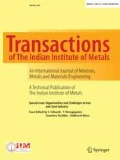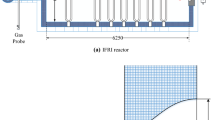Abstract
Cokemaking is an important unit operation in an integrated steel plant as coke quality has a strong influence on blast furnace performance. A two-dimensional (2D) model coupling physico-chemical phenomena inside combustion and coking chambers of a coke oven has been presented. It was implemented using the computational fluid dynamics software Ansys Fluent and was solved by a serial decoupling approach to improve convergence and to reduce computational time. The model predictions for gas temperatures inside the combustion chamber and the effect of coal moisture content on evolution of coke bed temperatures are in reasonable agreement with published experimental data. The computational time required for the 2D model is six times lower than that for a corresponding three-dimensional model. This model is useful for model-based optimization of cokemaking and for designing coke ovens with reduced computational burden.




Similar content being viewed by others
References
Loison R, Foch P, and Boyer A, Coke: Quality and Production. 2nd edn, Butterworth-Heinemann, Oxford (1989).
Isaev M V, and Sultanguzin, I A, Coke Chem, 53 (2010) p 305.
Toll H, and Worberg R, Rev Metall100 (2003) p 243.
Nomura S, Fuel Process Technol, 159 (2017) p 1.
Merrick D, Fuel, 62 (1983) p 534.
Atkinson B, and Merrick D, Fuel, 62 (1983) p 553.
Osinski E J, Barr P V, and Brimacombe J K, Ironmak Steelmak, 20 (1993) p 350.
Lin W, Feng Y, and Zhang X, Appl Thermal Eng, 81 (2015) p 353.
Merrick D, Fuel, 62 (1983) p 547.
Das S K, Godiwalla K M, and Mehrotra S P, High Temp Mater Process, 26 (2007) p 43.
Jin K, Feng Y, Zhang X, Wang M, Yang J, and Ma X, Appl Therm Eng, 58 (2013) p 354.
Zhang A Q, Feng Y H, Zhang X X, Wang M D, Yang J F and Xu Y, ISIJ Intl, 53 (2013) p 995.
Gamrat S, Poraj J, Bodys J, Smolka J, and Adamczyk W, Fuel Process Technol152 (2016) p 430.
Li Z, Yi Q, Zhang Y, Zhou H, Zhao Y, Huang Y, Gao D, and Hao Y, J Clean Prod, 252 (2020) p 119656.
Guo Z and Tang H, China Particuol, 3 (2005) p 373.
Słupik L, Fic A, Buliński Z, Nowak A J, Kosyrczyk L, and Łabojko G, Fuel, 150 (2015) p 415.
Poraj J, Gamrat S, Bodys J, Smolka J, and Adamczyk W, Clean Technol Environ Policy, 18 (2016) p 1815.
Zheng Q, and Wei H, Energy Fuels, 27 (2013) p 3570.
Buczynski R, Weber R, and Kim R, Schwöppe P, Appl Therm Eng, 144 (2018) p 170.
Tian Z, Li S, Wang Y, J Chem Eng Jpn, 51 (2018) p 683.
ANSYS Fluent User Guide R17, ANSYS, Inc., Canonsburg, PA, USA (2016).
Patankar S V, Numerical Heat Transfer and Fluid Flow, Hemisphere, New York (1980).
Acknowledgements
The authors thank the management of Tata Consultancy Services Limited to publish this work, and Mr. K. Ananth Krishnan and Dr. Gautam Shroff for their encouragement and support.
Author information
Authors and Affiliations
Corresponding author
Ethics declarations
Conflict of interest
The authors declare that there is no conflict of interest.
Additional information
Publisher's Note
Springer Nature remains neutral with regard to jurisdictional claims in published maps and institutional affiliations.
Rights and permissions
About this article
Cite this article
Beejawat, S., Parihar, M.S., Premraj, K. et al. Numerical Simulation of a Coke Oven Using Decoupling Techniques. Trans Indian Inst Met 73, 1709–1714 (2020). https://doi.org/10.1007/s12666-020-02023-6
Received:
Accepted:
Published:
Issue Date:
DOI: https://doi.org/10.1007/s12666-020-02023-6




